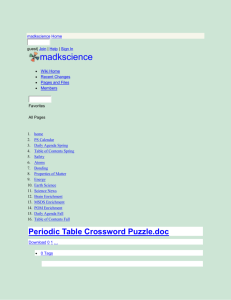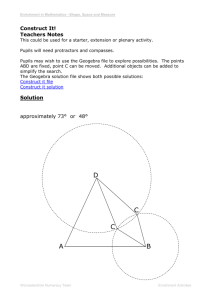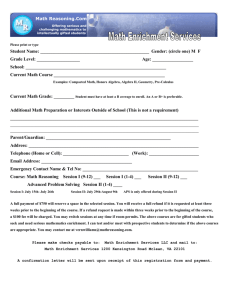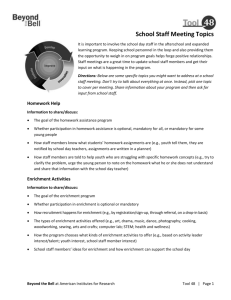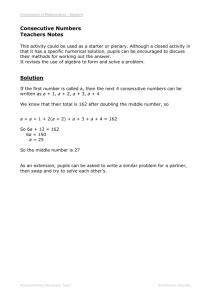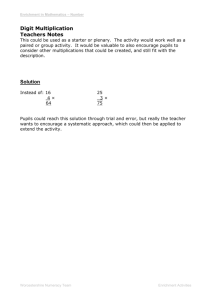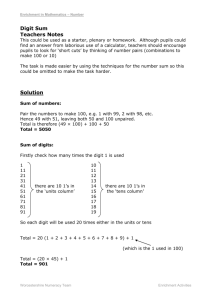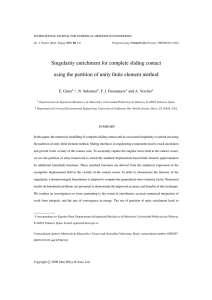2004 - 21st Century Science Initiative, Palisades, New York
advertisement
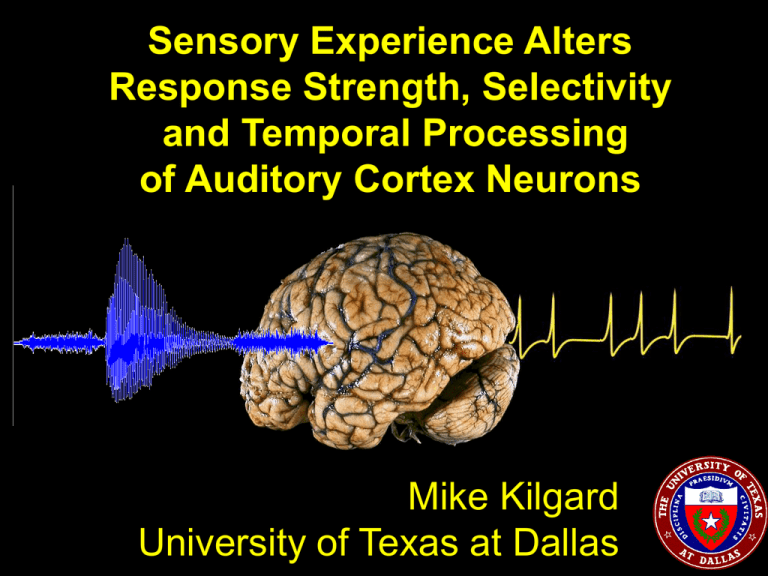
Sensory Experience Alters Response Strength, Selectivity and Temporal Processing of Auditory Cortex Neurons Mike Kilgard University of Texas at Dallas • Pioneering experiments by Hubel and Wiesel, Merzenich, Weinberger, Greenough, and many others have shown that cortical circuits are highly adaptive. Action Potentials • Neural plasticity is likely involved in perceptual learning, development, and recovery from brain injury. Tone Frequency Cochlea Cortex Frequency Time 15 Word Speech Stream >1045 possibilities Techniques used to study how complex sounds alter cortical processing Behavioral Training Nucleus Basalis Stimulation Environmental Enrichment Environmental enrichment increases: • • • • • • • Brain weight Gene expression Cortical thickness Dendritic branching Acetylcholinesterase levels Oligodendrocyte to neuron ratio Number of synapses per neuron What are the physiological consequences of these anatomical changes? Red Group Enriched Blue Enriched Amplitude (mV) .10 Week 1 Week 2 Week 5 Week 12 .05 0 -.05 -.10 0 50 100 150 200 250 Time (ms) 22 rats total 0 50 100 150 200 250 Time (ms) 0 50 100 150 200 250 Time (ms) 20±10 vs. 75±20 μV 0 50 100 150 200 250 Time (ms) 81±19 vs. 37±20 μV Journal of Neurophysiology, 2004 Environmental Enrichment • • • • Rapid Dramatic Reversible No critical period Environmental Enrichment • • • • State dependent? Other response properties change? Consequences for speech processing? What aspects of enrichment are required? – Exercise – Social – Sensory • Cellular mechanisms? High-density Microelectrode Mapping Plasticity in Primary Auditory Cortex B. 80 60 60 C. 80 BW40 BW40 40 BW30 BW30 40 BW20 BW20 20 BW10 BW10 20 1 2 4 8 16 60 First Spike Latency 40 20 End of Response CF CF 0 Enriched Standard 100 Peak Latency Spikes/s Intensity (dB SPL) A. 80 0 32 1 2 4 8 16 32 Frequency (kHz) Enriched Housing Standard Housing 0 0 10 20 30 Time (ms) 40 Enrichment effects persist under general anesthesia • 40% increase in response strength – 1.4 vs. 1.0 spikes per noise burst (p< 0.00001) • 10% decrease in frequency bandwidth – 2.0 vs. 2.2 octaves at 40dB above threshold (p< 0.05) • 3 dB decrease in threshold – 17.2 vs. 20 dB (p< 0.001) n = 16 rats, 820 A1 sites Journal of Neurophysiology, 2004 Frequency Consequences for speech processing? Time 200ms ISI 200 ms Interstimulus Interval Enriched Standard 60 Enrichment Increases Paired Pulse Depression 40 Voltage (microvolts) 20 0 -20 -40 -60 -100 0 100 200 300 400 500 Time (milliseconds) 600 700 800 900 1 Paired Pulse Ratio (2nd/1st) 0.9 0.8 0.7 0.6 0.5 0.4 0.3 0.2 0.1 Enriched Standard 0 50ms 100ms 200ms 500ms Interstimulus Interval (milliseconds) • Response of Neurons at a Single Site to Repeated Tones • Group Average Enriched housing alters temporal processing Decrease in best rate by 1.1 Hz in enriched rats 7.8 vs. 6.7 Hz (p< 0.001) Environmental Enrichment • • • • • Rapid Dramatic Reversible No critical period Alters temporal processing Why? Exercise can cause: and WATER • A persistent firing pattern in the rat hippocampus, known as theta-rhythm • Increased release of brain-derived neurotrophic factor and other growth factors • Changes in gene regulation • Increased cell proliferation and neurogenesis in the adult mouse dentate gyrus Social Interactions can: and WATER • enhance some forms of learning • alter stress hormones • improve recovery from brain damage Auditory Exposure Enriched Auditory Environment Nucleus Basalis and Plasticity • Nucleus basalis neurons are activated by any arousing stimuli. • Cholinergic agonists and NB stimulation increase plasticity. • Cholinergic antagonists and NB lesions prevent many forms of cortical plasticity. No effect on evoked potentials Auditory Enrichment • • • • • • • Rapid Dramatic Reversible No critical period Alters temporal processing Not dependent on nucleus basalis Not dependent on exercise or social interactions Time Frequency Acknowledgements: Enrichment Evoked Potentials - Cherie Percaccio Enrichment A1 Experiments - Navzer Engineer For more information visit: www.utd.edu/~kilgard Sash kHz Spikes per second Site Number High Low Time (msec) Spectrotemporal discharge patterns of A1 neurons to ‘sash’ (n= 12 rats, 445 cortical sites) E) Frequency (kHz) 'back' 25 20 10 5 25 20 10 5 Spike Rate (Hz) A) 150 100 50 0 150 100 50 0 Spike Frequency Rate (Hz) (kHz) B) 'pack' Frequency Spike Rate (Hz) (kHz) Spike Rate (Hz) D) F) 25 20 10 5 25 20 10 5 150 100 50 0 150 100 50 0 C) 'back' - modified 'sash' 'pack' - modified G) 25 20 10 5 25 20 10 5 150 100 50 0 150 100 50 0 'sash' - modified Neural responses to normal speech H) Neural responses to modified speech 150 100 50 back 150 a sh pack 100 50 50 100 150 200 250 300 350 Time (ms) ba s p a ck a sh ck 50 100 150 200 250 300 350 Time (ms) Individual Rat Voltage (microvolts) 150 Before During After 100 50 0 -50 -100 -150 0 100 200 300 400 500 600 Time (milliseconds) 700 800 900 Mean of Five Rats Voltage (microvolts) 75 Before During After 50 25 0 -25 -50 -75 0 100 200 300 400 500 600 Time (milliseconds) 700 800 900 Voltage (microvolts) 150 100 50 0 -50 -100 -150 Voltage (microvolts) Individual Rat 75 50 25 0 -25 -50 -75 Before During After 0 100 200 300 400 500 600 700 800 900 Time (milliseconds) Before Mean of Five Rats During After 0 100 200 300 400 500 600 700 800 900 Time (milliseconds)
